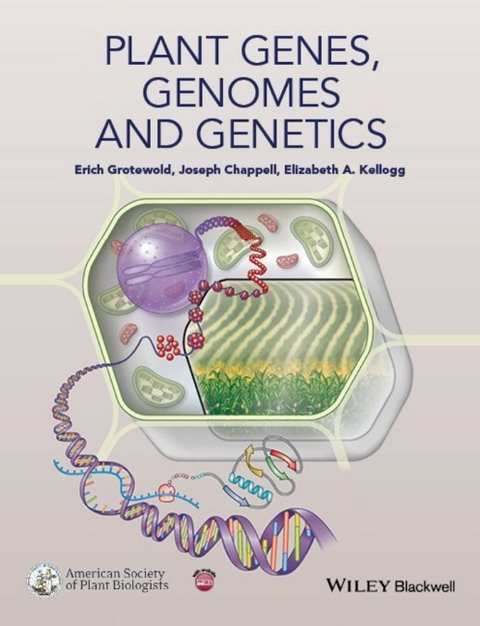
Plant Genes, Genomes and Genetics
Wiley-Blackwell (Verlag)
978-1-119-99887-7 (ISBN)
Written by a highly respected team of specialists in plant biology with extensive experience in teaching at undergraduate and graduate level, this textbook will be invaluable for students and instructors alike. Plant Genes, Genomes and Genetics also includes:
specific examples that highlight when and how plants operate differently from other organisms
special sections that provide in-depth discussions of particular issues
end-of-chapter problems to help students recapitulate the main concepts
rich, full-colour illustrations and diagrams clearly showing important processes in plant gene expression
a companion website with PowerPoint slides, downloadable figures, and answers to the questions posed in the book
Aimed at upper level undergraduates and graduate students in plant biology, this text is equally suited for advanced agronomy and crop science students inclined to understand molecular aspects of organismal phenomena. It is also an invaluable starting point for professionals entering the field of plant biology.
Dr Erich Grotewold is currently a professor in the Department of Molecular Genetics (College of Arts & Sciences) as well as in the Department of Horticulture & Crop Sciences (College of Food, Agriculture & Environmental Sciences) at The Ohio State University. His research focuses on plant systems biology. Dr Joseph Chappell joined the faculty at the University of Kentucky in 1985, where he has developed an internationally recognized research program pioneering the molecular genetics and biochemistry of natural products in plants. Dr Elizabeth A. Kellogg was formerly the E. Desmond Lee and Family Professor of Botanical Studies at the University of MissouriSt. Louis, and is currently a Member of the Donald Danforth Plant Science Center in St. Louis. Her work focuses on the evolution of plant genes, genomes and development, particularly in the cereal crops and their wild relatives.
Acknowledgements xi
Introduction xiii
About the Companion Website xix
PART I: PLANT GENOMES AND GENES
Chapter 1 Plant genetic material 3
1.1 DNA is the genetic material of all living organisms, including plants 3
1.2 The plant cell contains three independent genomes 8
1.3 A gene is a complete set of instructions for building an RNA molecule 10
1.4 Genes include coding sequences and regulatory sequences 11
1.5 Nuclear genome size in plants is variable but the numbers of protein-coding, non-transposable element genes are roughly the same 12
1.6 Genomic DNA is packaged in chromosomes 15
1.7 Summary 15
1.8 Problems 15
References 16
Chapter 2 The shifting genomic landscape 17
2.1 The genomes of individual plants can differ in many ways 17
2.2 Differences in sequences between plants provide clues about gene function 20
2.3 SNPs and lengthmutations in simple sequence repeats are useful tools for genome mapping and marker assisted selection 22
2.4 Genome size and chromosome number are variable 28
2.5 Segments of DNA are often duplicated and can recombine 30
2.6 Some genes are copied nearby in the genome 31
2.7 Whole genome duplications are common in plants 34
2.8 Whole genome duplication has many effects on the genome and on gene function 37
2.9 Summary 41
2.10 Problems 42
Further reading 42
References 42
Chapter 3 Transposable elements 45
3.1 Transposable elements are common in genomes of all organisms 45
3.2 Retrotransposons are mainly responsible for increases in genome size 46
3.3 DNA transposons create small mutations when they insert and excise 52
3.4 Transposable elements move genes and change their regulation 57
3.5 How are transposable elements controlled? 60
3.6 Summary 60
3.7 Problems 61
References 61
Chapter 4 Chromatin, centromeres and telomeres 63
4.1 Chromosomes are made up of chromatin, a complex of DNA and protein 63
4.2 Telomeres make up the ends of chromosomes 66
4.3 The chromosome middles–centromeres 71
4.4 Summary 77
4.5 Problems 77
Further reading 77
References 77
Chapter 5 Genomes of organelles 79
5.1 Plastids and mitochondria are descendants of free-living bacteria 79
5.2 Organellar genes have been transferred to the nuclear genome 80
5.3 Organellar genes sometimes include introns 82
5.4 Organellar mRNA is often edited 82
5.5 Mitochondrial genomes contain fewer genes than chloroplasts 84
5.6 Plant mitochondrial genomes are large and undergo frequent recombination 87
5.7 All plastid genomes in a cell are identical 91
5.8 Plastid genomes are similar among land plants but contain some structural rearrangements 93
5.9 Summary 95
5.10 Problems 95
Further reading 95
References 95
PART II: TRANSCRIBING PLANT GENES
Chapter 6 RNA 99
6.1 RNA links components of the Central Dogma 99
6.2 Structure provides RNA with unique properties 102
6.3 RNA has multiple regulatory activities 105
6.4 Summary 108
6.5 Problems 108
References 109
Chapter 7 The plant RNA polymerases 111
7.1 Transcription makes RNA from DNA 111
7.2 Varying numbers of RNA polymerases in the different kingdoms 112
7.3 RNA polymerase I transcribes rRNAs 114
7.4 RNA polymerase III recruitment to upstream and internal promoters 116
7.5 Plant-specific RNP-IV and RNP-V participate in transcriptional gene silencing 117
7.6 Organelles have their own set of RNA polymerases 117
7.7 Summary 118
7.8 Problems 118
References 118
Chapter 8 Making mRNAs – Control of transcription by RNA polymerase II 121
8.1 RNA polymerase II transcribes protein-coding genes 121
8.2 The structure of RNA polymerase II reveals how it functions 121
8.3 The core promoter 123
8.4 Initiation of transcription 125
8.5 The mediator complex 127
8.6 Transcription elongation: the role of RNP-II phosphorylation 128
8.7 RNP-II pausing and termination 129
8.8 Transcription re-initiation 130
8.9 Summary 130
8.10 Problems 130
References 130
Chapter 9 Transcription factors interpret cis-regulatory information 133
9.1 Information on when, where and how much a gene is expressed is codified by the gene’s regulatory regions 133
9.2 Identifying regulatory regions requires the use of reporter genes 134
9.3 Gene regulatory regions have a modular structure 135
9.4 Enhancers: Cis-regulatory elements or modules that function at a distance 137
9.5 Transcription factors interpret the gene regulatory code 138
9.6 Transcription factors can be classified in families 138
9.7 How transcription factors bind DNA 139
9.8 Modular structure of transcription factors 143
9.9 Organization of transcription factors into gene regulatory grids and networks 146
9.10 Summary 146
9.11 Problems 146
More challenging problems 147
References 147
Chapter 10 Control of transcription factor activity 149
10.1 Transcription factor phosphorylation 149
10.2 Protein–protein interactions 151
10.3 Preventing transcription factors from access to the nucleus 155
10.4 Movement of transcription factors between cells 156
10.5 Summary 158
10.6 Problems 158
References 158
Chapter 11 Small RNAs 161
11.1 The phenomenon of cosuppression or gene silencing 161
11.2 Discovery of small RNAs 162
11.3 Pathways for miRNA formation and function 163
11.4 Plant siRNAs originate from different types of double-stranded RNAs 166
11.5 Intercellular and systemic movement of small RNAs 168
11.6 Role of miRNAs in plant physiology and development 170
11.7 Summary 171
11.8 Problems 171
References 172
Chapter 12 Chromatin and gene expression 173
12.1 Packing long DNA molecules in a small space: the function of chromatin 173
12.2 Heterochromatin and euchromatin 173
12.3 Histone modifications 174
12.4 Histone modifications affect gene expression 175
12.5 Introducing and removing histone marks: writers and erasers 175
12.6 ‘Readers’ recognize histone modifications 177
12.7 Nucleosome positioning 177
12.8 DNA methylation 178
12.9 RNA-directed DNA methylation 179
12.10 Control of flowering by histone modifications 180
12.11 Summary 181
12.12 Problems 181
References 181
PART III: FROM RNA TO PROTEINS
Chapter 13 RNA processing and transport 185
13.1 RNA processing can be thought of as steps 185
13.2 RNA capping provides a distinctive 5’ end to mRNAs 185
13.3 Transcription termination consists of mRNA 3’-end formation and polyadenylation 189
13.4 RNA splicing is another major source of genetic variation 192
13.5 Export of mRNA from the nucleus is a gateway for regulating which mRNAs actually get translated 194
13.6 Summary 196
13.7 Problems 196
References 196
Chapter 14 Fate of RNA 199
14.1 Regulation of RNA continues upon export from nucleus 199
14.2 Mechanisms for RNA turnover 199
14.3 RNA surveillance mechanisms 201
14.4 RNA sorting 202
14.5 RNA movement 203
14.6 Summary 204
14.7 Problems 204
Further reading 205
References 205
Chapter 15 Translation of RNA 207
15.1 Translation: a key aspect of gene expression 207
15.2 Initiation 209
15.3 Elongation 209
15.4 Termination 210
15.5 Tools for studying the regulation of translation 211
15.6 Specific translational control mechanisms 211
15.7 Summary 213
15.8 Problems 214
Further reading 214
References 214
Chapter 16 Protein folding and transport 215
16.1 The pathway to a protein’s function is a complicated matter 215
16.2 Protein folding and assembly 215
16.3 Protein targeting 218
16.4 Co-translational targeting 218
16.5 Post-translational targeting 219
16.6 Post-translational modifications regulating function 220
16.7 Summary 222
16.8 Problems 223
Further reading 223
References 224
Chapter 17 Protein degradation 225
17.1 Two sides of gene expression–synthesis and degradation 225
17.2 Autophagy, senescence and programmed cell death 225
17.3 Protein-tagging mechanisms 226
17.4 The ubiquitin proteasome system rivals gene transcription 228
17.5 Summary 231
17.6 Problems 231
Further reading 231
Reference 231
Index 233
| Erscheint lt. Verlag | 2.6.2015 |
|---|---|
| Verlagsort | Hoboken |
| Sprache | englisch |
| Maße | 191 x 246 mm |
| Gewicht | 581 g |
| Themenwelt | Naturwissenschaften ► Biologie ► Botanik |
| Naturwissenschaften ► Biologie ► Genetik / Molekularbiologie | |
| ISBN-10 | 1-119-99887-5 / 1119998875 |
| ISBN-13 | 978-1-119-99887-7 / 9781119998877 |
| Zustand | Neuware |
| Haben Sie eine Frage zum Produkt? |
aus dem Bereich


